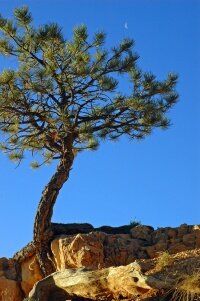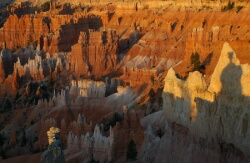|
|
 |
General Visitor Information
Open year around. A One Day
Agenda: Stop at the Visitor Center for information, exhibits, and a
22-minute award-winning film which plays on the hour and half-hour.
Publications and maps are available for
purchase through our Bryce Canyon Natural History Association.
Drive to Sunrise, Sunset, Inspiration
and Bryce viewpoints. Hike a portion of the rim trail or one of the
shorter under-the-rim trails. |
|
|
At Bryce Canyon National Park, erosion has
shaped colorful Claron limestones, sandstones, and mudstones into
thousands of spires, fins, pinnacles, and mazes. Collectively called
"hoodoos," these colorful and whimsical formations stand in
horseshoe-shaped amphitheaters along the eastern edge of the Paunsaugunt
Plateau in Southern Utah.
 Bryce Canyon is a small national park
in southwestern Utah. Named after the Mormon Pioneer Ebenezer Bryce, Bryce
Canyon became a national park in 1924. Bryce Canyon is a small national park
in southwestern Utah. Named after the Mormon Pioneer Ebenezer Bryce, Bryce
Canyon became a national park in 1924.
Bryce is famous for its worldly unique geology, consisting of a series
of horseshoe-shaped amphitheaters carved from the eastern edge of the
Paunsaugunt Plateau in southern Utah. The erosional force of frost-wedging
and the dissolving power of rainwater has shaped the colorful limestone
rock of the Claron Formation into bizarre shapes including slot canyons,
windows, fins, and spires called "hoodoos." Tinted with colors too
numerous and subtle to name, these whimsically arranged rocks create a
wondrous landscape of mazes, offering some of the most exciting and
memorable walks and hikes imaginable.
Ponderosa pines, high elevation meadows, and fir-spruce forests border
the rim of the plateau and abound with wildlife. This area boasts some of
the world's best air quality, offering panoramic views of three states and
approaching 200 miles of visibility. This, coupled with the lack of nearby
large light sources, creates unparalleled opportunities for stargazing.
|

